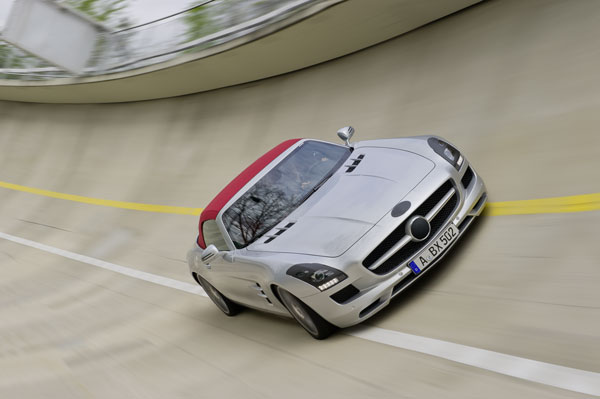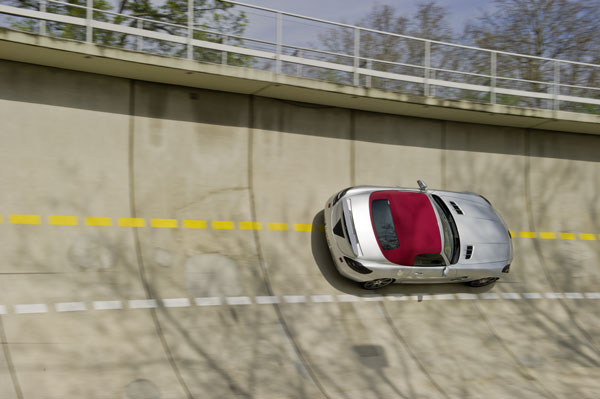2012 SLS AMG Roadster Convertible Gives Up Gullwings for Soft Top

The convertible SLS AMG Roadster is the second car to be developed independently by AMG. The Coupe and Roadster concepts were created in parallel – very advantageous during the development process. During this 3-year development period for the 2012 SLS AMG Roadster, the engineers devoted particular attention to bodyshell rigidity, driving dynamics, the soft top and NVH.
Currently undergoing testing in Stuttgart, the 2012 SLS AMG Roadsters
are minimally disguised as they cover their test routes. Easily
identified by enthusiasts, these two-seaters with a fabric soft top have
no Mercedes stars or model designations to be seen, just black adhesive
foil at the front, rear and along the sides. The proportions speak for
themselves with a long hood, large wheels and a short rear unified by
breathtaking design.
There are still six months to go before the world premiere at the
International Automobile Show in Frankfurt in September 2011. Time
enough to verify the maturity of the new SLS AMG Roadster. The personnel
responsible at AMG have already completed most of the work involved
since the Coupé and Roadster were created in parallel. The development
and testing of a new AMG high-performance car is based on the digital
prototype (DPT). Extensive investigations help to achieve specific
objectives such as the bodyshell design, weight distribution, engine
position, center of gravity or axle design. The very latest simulation
programs allow engineers to test handling dynamics, aerodynamics,
ergonomics, crash behavior and production process. The digital prototype
is therefore a complete, virtual automobile.
In the process AMG also uses the extensive know-how of colleagues at
Mercedes-Benz, working with select Mercedes-Benz development departments
at the Mercedes Technology Center (MTC) in Sindelfingen.
The latest simulation software and extensive test drives on all
continents make the 563 hp Roadster fit for its U.S. market launch in
late 2011. The specialists in Affalterbach particularly focused on
bodyshell rigidity, handling dynamics, the soft top and NVH – “Noise,
Vibration and Harshness”.

Synthesis: rigidity, performance and a close-fitting soft top
Naturally all these development aspects are closely linked, as Tobias
Moers (44), head of overall development and member of the Executive
Board at Mercedes- AMG, explains: “Without bodyshell rigidity there are
no handling dynamics, and neither can the close fit of the soft top be
guaranteed.” As the Roadster variant was already taken into
consideration during the conceptual phase for the SLS AMG, the
lightweight and extremely rigid aluminum spaceframe was specified at a
correspondingly early stage. Due to the lack of a fixed roof and
gullwing doors, it was necessary to design the side skirts more
robustly, not just for crash performance, but because test drives showed
that the driving dynamics could be improved even further by
strengthening this area. Tobias Moers: “The SLS AMG Roadster is a
super-sportscar – just like the Coupe. It goes without saying that AMG
is also determined to achieve superior driving dynamics with this
convertible variant.”
In order to achieve handling dynamics identical to the Coupé – without a
fixed roof – the Roadster has two features designed to increase the
rigidity of the bodyshell: the cross-member carrying the dashboard has
additional supporting struts at the windshield frame and at the center
tunnel, and a structure between the soft top and the tank stiffens the
rear axle. These features prevent unwanted vibrations from the start and
dispose of additional weight-increasing vibration dampers often
employed by competitors. Because of this rigidity, the soft top can be
reliably opened and closed electrohydraulically at speeds up to while on
the move at up to 31 mph. The bodyshell of the Roadster tips the scales
at only 536 pounds – which is comparable to the low, 531 pounds of the
SLS AMG Coupes bodyshell.
A few specific modifications to the aluminum spaceframe
Without a fixed roof and gullwing doors, the convertible SLS AMG has a
reinforcing cross-member behind the seats which supports the fixed
rollover protection system. The 250-watt subwoofer of the
Bang&Olufsen BeoSound AMG high-end sound system is located in the
cross-member rather than the parcel shelf of the Coupe. One particular
challenge was acoustic insulation of the cross-member, which acts as a
subwoofer housing for the two 6.5-inch speakers connected in series.
Numerous improvements became necessary before the required listening
pleasure was met. It was only with the help of a special bulkhead within
the aluminum cross-member that the system was deemed ready.
The three-layer fabric soft top of the SLS AMG Roadster, which is stored
behind the seats in a Z-formation to save space, is also relevant to
handling dynamics. This weight-optimized magnesium/steel/ aluminum
construction provides a low center of gravity and is designed for speeds
up to the maximum of 197 mph (electronically limited). Engineers
stressed that whether open or closed, even at top speed there must be no
intrusive flapping, booming, hissing, clattering, whistling or howling.
Likewise the plexi-glass windstop and the paneling in the interior, on
the soft top and along the beltline must be vibration-free. These
precisely defined tests were conducted on the high-speed tracks in
Papenburg, Nardo (Italy) and Idiada (Spain).
The superior acoustics, which AMG engineers verified with sophisticated
measuring technology, also benefit from another special feature – the
seamless, bonded-in rear window made of single-layer safety glass. A
special production process not only provides a smooth transition between
the outer skin of the soft top and the glass but also leads to low wind
noise when the roof is closed – at any speed.
125 years of experience with innovations in convertible vehicles
Ensuring that the soft top is wind and water-proof is a complex
undertaking, and AMG and Mercedes-Benz have used the enormous experience
gained during 125 years of innovation. There have always been
convertible vehicles throughout Mercedes-Benz history.
AMG developers of the 2012 SLS AMG Roadster paid great attention to
water, sand, dust, heat and cold. One special feature of the compact
soft top is the continuous water pocket: this is attached below the soft
top to catch rainwater and direct it down to the underbody via two
openings on each side.
Endurance test with 16 criteria: the “Sindelfingen rain test”
The rain test at the Mercedes Technology Center (MTC) in Sindelfingen is
particularly demanding and every new vehicle bearing the Mercedes star
is required to pass it – whether it has a fixed roof, a soft top or a
retractable hardtop. Extreme amounts of water are used to ensure that
the result of the development work is watertight – which is a particular
challenge in the case of roadsters or convertibles. 16 tests must be
successfully passed before approval is granted.
Tests include the hose test – when all soft top, door and flap seals are
sprayed with a water-hose; the continuous overnight rain test, the
fording test, the icing, swirl and high-pressure tests, and a final
session in an automatic car wash. The rain test simulates every
conceivable situation that can occur on any continent.
Bench testing and practical trials in all climatic zones
In addition to various test facilities such as the water chamber and the
climate/ wind tunnel, the AMG specialists conduct test drives in all
climatic regions of the world. In Laredo, Texas, for example, there is a
particularly fine dust which finds its way into practically any gap,
testing the absolute limits of the seals.
The compact fabric soft top, which can be conveniently opened and closed
in just 11 seconds at the touch of a button at speeds up to 31 mph,
must also submit to various tortures. One of these is the standardized
soft top endurance test used for all new Mercedes roadsters and
convertibles: 20,000 closing cycles on a stationary test rig, followed
by 2,500 closing cycles while on the move (whether in extreme heat, icy
cold, high humidity or dry desert winds).
Endurance trial as a final quality check
Even though all the development tests have been passed, and the
production tests at the Mercedes-Benz plant in Sindelfingen have been
successful, the developers still haven’t reached their goal. The focus
now turns to the quality of the overall vehicle during endurance trials.
These simulate an entire vehicle life under the toughest conditions in
accelerated test cycles.
The endurance testing at a glance
Long-term testing on a variety of different roads:all the components and systems are tested together in everyday
operation. Loaded up to their permitted gross vehicle weight, the test
cars are put through a precisely defined test program on country roads,
highways and in city traffic.
Endurance testing on unpaved surfaces:in this case, the developers focus on the durability of the chassis
and suspension components, the entire bodyshell and the integral
subframe on which the front axle, steering and engine are mounted. The
test cars are loaded up to their permitted gross vehicle weight.
“Accelerated” endurance testing:testing of the entire vehicle, focusing on the powertrain, chassis
and suspension. Special features of the AMG program include 6,200 miles
on both the Nu¨rburgring’s North Loop and in city traffic.
Full-load endurance testing:extreme acceleration and braking maneuvers with a frequent full-load
operation, which place extreme demands on the cooling, fuel-delivery
and braking systems.
Long-term corrosion testing:corrosion testing of the entire vehicle simulates the toughest dynamic and climatic environmental influences.
Final board approval:all-inclusive verification of the finished product.
Content provided by Mercedes-Benz
